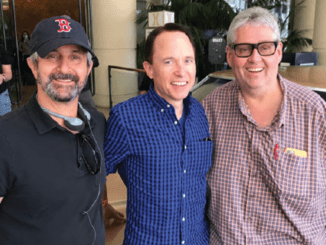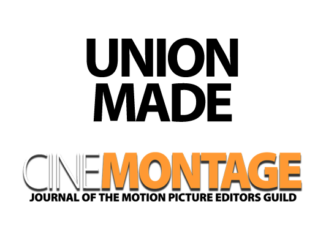
by Ray Zone
Production Culture
Industrial Reflexivity and Critical Practice in Film and Television
by John Thornton Caldwell
Duke University Press
451 pps. paperbound, $25.95
ISBN: 9778-0-8223-4111-6
There are not many anthropological studies of the filmmaking culture in Hollywood. The last one was Hollywood, The Dream Factory: An Anthropologist Looks at the Movie-Makers by Hortense Powdermaker, published in 1950 by Little, Brown and Company. Powdermaker went to the movie capital “to learn how the social structure of Hollywood affects the final product” and because “all art, whether popular, folk or fine, is conditioned by its particular history and system of production.”
Now, John Thornton Caldwell, a Professor of Cinema and Media Studies at UCLA, has published an up-to-date “field study” of contemporary production “on a micro-social level as local cultures and social communities in their own right.” He was also interested in studying the industry’s own self-representation, self-critique and self-reflection in using a form of “interpretive anthropology” to explore the cultural practices and belief systems of film/video production workers in Los Angeles. In particular, Caldwell paid special attention to the below-the-line workers in the industry that included cinematographers, editors, gaffers and grips.
Industrial self-theorizing and sense-making are widespread in the production culture today, as seen by great general interest in behind-the-scenes featurettes on DVDs, Internet and television. This contemporary phenomenon is examined in fastidious detail in two separate chapters, one of which is titled “Industrial Reflexivity as Viral Marketing.” But Caldwell characterized this self-representation as “unintentional and effacing” on the part of below-the-line workers and noted that they seldom talk of imposing their will or vision upon filmed material.
Not surprisingly, Caldwell observed a kind of “inverse credibility law” where “the higher one travels up the industrial food chain for insights, the more suspect and spin-driven the personal disclosures tend to become.” By habit, producers and executives tend to speak from corporate “scripts,” conversing in “tightly crafted pre-fab sound bites.”
Speed-production location methods for reality television have contributed to the digital sweatshop.
One of the great things about this book is Caldwell’s up-to-date coverage of changes in production technology that have affected what he calls “industrial self-disclosure.” He notes that terms are clearly needed to describe recent trends such as “migratory labor and churn, outsourcing’s bid culture, speed shooting and hyper-production, the digital sweatshop and the collapsed workflow caused by the ‘DI’ [digital intermediate].”
Characterizing the new digital post-production industrial economy as “Post-Fordist” (in contradistinction to studio-style assembly-line work), Caldwell notes, “The ever-increasing shrinkage of post-production and graphics workstations to a PC/desktop scale in the 1990s, for example, lowered the barriers for entry into the editing, animation and effects trades for many new workers.” When Walter Murch, A.C.E., edited the Oscar-nominated feature film Cold Mountain on Final Cut Pro in 2003, Caldwell observed, “Newcomers celebrated this ‘liberation,’ while established companies anxiously tried to figure out how to deal with competitors who no longer necessarily needed expensive company infrastructure [offices, buildings, assistants] to pull off contracted work.”
This trend has also contributed to the formation of the digital sweatshop as well as industry downsizing. “Editing and post-production houses contribute to the sweatshop reputation,” writes Caldwell. “But they do so in ways that differ from those of the digital effect and animation houses. By shrinking the editing task to desktop scale, Mac and personal computer-based post-production workstations today allow and encourage the user to cross all sorts of previously sacred and well-guarded trade boundaries. Avid or Final Cut Pro editors today do not just cut shots together but also mix sound, cut dialogue, design and incorporate special effects, and maintain the engineering and technical quality of the image and sound they are cutting.”
Within contemporary “self-representation” of below-the-line work is the image of the solitary digital artist/editor as a bunkered and isolated figure. This image has been exploited in ProMax’s Final Cut Pro equipment demo reel and the VI” demo from Lightworks. Caldwell also notes that the manufacturer of Blue, a nonlinear cross-platform post-production system, furthers the myth of the editor as “alienated man and tortured artist.” This piece depicts a lone man in an edit suite pacing nervously in nocturnal lighting under an overhead ceiling fan. A male narrator intones “a litany of ulcer-inducing pitfalls that haunt the user” as “lingering shots of the sweating, twisted body of the [now] T-shirt clad editor––shown tangled in endless cables as he troubleshoots–– builds eventually to a crisis and major plot point.” It’s a “nonlinear nightmare” dramatizing isolated male trauma, which is then distributed to a broader public sphere of production professionals on demo DVDs. These video portraits, as Caldwell points out, dramatize the “quasi-private workspace of professional artisan-technicians” as “a place of forced labor.”
Speed-production location methods for reality television have also contributed to the digital sweatshop with “scriptless mountains of raw footage that can neither be pre-assembled nor rough cut according to some pre-existing screenplay or shot sequence.” The editor’s task in such a reality series, Caldwell notes, “is as mind-numbing as the camera operator’s task is physically grueling.”
John Caldwell characterized this self-representation as “unintentional and effacing” on the part of below-the-line workers and noted that they seldom talk of imposing their will or vision upon filmed material.
Another result of the digital toolset is the acute camera style and dominance of electronic colorists. “Editing film electronically now means that film editors have the same kind of ‘real-time’ image manipulation tools on their Avids that video editors have almost always had,” Caldwell observes. “Many more hands are therefore tangled up in ‘cooking’ the film image before it ever sees the light of a projected print.”
In an insightful chapter titled “Industrial Identity Theory,” Caldwell speculates about the importance of creative vision in the new media business at every level of production. In a time of unprecedented technological change, creative passion can be a sustaining force amidst the evolving digital maelstrom.





